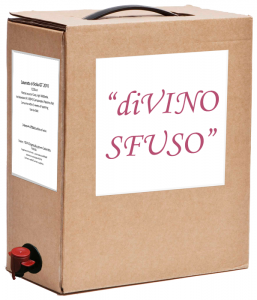The Bag-in-Box
How the Bag-in-Box is made
The Bag-in-Box much used by our online wine shop is a container for liquid foods invented and patented in the 1950s in the United States of America. It consists of a box, usually of cardboard of various shapes and sizes that serves to protect and hold a bag made of plastic polylaminate (metallized polyester for the outside and polyethylene for food products for the inside) with a heat-sealed tap dispenser. The latter is the key part of this innovative container because it allows liquids out but not air in.
The history of Bag-in-Box
Use of this container for wine began only quite recently, initially for the Northern Europe market and later also in Italy where its penetration was initially complicated by traditional factors (obviously linked to the use of bottles in glass for the “nectar of Bacchus”) and a certain diffidence (linked to the fact that in the early days low-quality wines were usually packaged in this NEW container). Today the situation has changed considerably because the innumerable advantages offered by the Bag-in-Box are much appreciated by consumers.
The advantages of the Bag-in-Box
Now let’s take a closer look at the advantages of the Bag-in-Box (also known as BiB). When the bag is filled with wine, no air remains inside it, but as it is emptied, the liquid flows out but no oxygen can get in. This is all thanks to the special system used to manufacture the tap and the flexibility of the bag’s material. This eliminates the possibility of oxidation and the acescence, typical problems that are found in wine stored in open bottles. So the Bag-in-Box is the best container on the market for everyday wines and it makes it possible to always keep the wine ready to use even for occasional and sporadic consumption.
As for the box, here too the advantages are innumerable. It protects the bag from crushing through impacts and tearing; it is stackable; it protects the wine from sudden changes in temperature and light; and, last but not least, it is an excellent solution for courier shipments since bottle shipments now require special packaging and are very expensive.
Bag-in-Box formats
Finally, we come to the formats. For wine the two most common are 3 litres and 5 litres, which are equivalent to about 4 bottles and 6 bottles of wine respectively, and thus very suitable for “domestic use”. There are also 10 and 20 litres formats for use in catering. This wide choice thus enables us to meet varying consumer requirements. So all we have to do now is to conclude by saying that the Bag-in-Box that’s perfect for you is already available on the market!
Two new containers, the evolution of the Bag-in-Box: the Bag-in-Tube® and the Pouch-Up®
The Bag-in-Tube® comprises a cardboard tube (with a lid and tin base) that has the company logo and information on the wine content printed on it. The tube contains a double-layer bag and the liquid is dispensed through the Vitop® high-performance tap. Like the Bag-in-Box, once opened, the Bag-in-Tube® protects the product from oxygen, making it the perfect packaging for the requirements of the occasional consumer. Its shape and elegant, eye-catching look, are perfect for a gift that’s a bit different. The soft braided rope handle simplifies transportation and adds a touch of further refinement.
The Pouch-Up® is a bag made of films with excellent oxygen protection properties in order to preserve the liquid inside and ensure that the wine remains uncontaminated by the outside air. The wine is tapped through a Vitop® compact tap, which prevents air from entering the packaging. Pouch-Up® stands on its own with the help of the double gussets, at both base and top. It is easy to transport using the handle formed from the upper gusset and once emptied it can be disposed of in plastic recycling bins.



